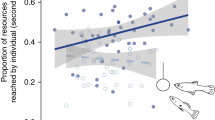Abstract
We extend the game theoretic model of kleptoparasitism discussed in Broom et al. (2004), by considering a population of foragers consisting of two groups with different behaviours—those who forage and steal from other feeders, and those who only forage. We a sume that those who do not steal have a better foraging rate than those who are also looking out for opportunities to steal. We also allow either type to resist an attack or not resist. We look for Evolutionary Stable States, of either a mixture of the two behaviours, or where the whole population has just one of these behaviours. We find nine such ESS’s, dependent on the environmental parameters, although in fact only five of these are distinguishable. In general, we find that if the overall population density is low, food-stealing becomes less viable, and there is an ESS consisting of only foragers. Conversely, when there are many animals looking for, and finding, food, there is an ESS consisting of just kleptoparasites (which are also foraging). In between, an ESS will contain both pure-foragers and stealers. There is some empirical evidence of such behaviours.
We find that when there is a mixture of the two types, they must both have the same resistive behaviour. We can thus have some individuals challenging for food but not resisting challenges, and others not challenging and not resisting. This shows how aggressive behaviour may be context-dependent, as seen in practice.
Similar content being viewed by others
References
Barnard, C.J., Sibly, R.M., 1981. Producers and scroungers: A general model and its application to captive flocks of house sparrows. Ani. Beha. 29, 543–555.
Brockmann, H.J., Barnard, C.J., 1979. Kleptoparasitism in birds. Anim. Beha. 27, 487–514.
Broom, M., Ruxton, G.D., 1998. Evolutionarily stable stealing: Game theory applied to kleptoparasitism. Beha. Ecol. 9, 397–403.
Broom, M., Ruxton, G.D., 2003. Evolutionarily stable kleptoparasitism: Consequences of different prey types. Beha. Ecol. 14, 23–33.
Broom, M., Luther, R.M., Ruxton, G.D., 2004. Resistance is useless? Extensions to the game theory of kleptoparasitism. Bull. Math. Biol. 66, 1645–1658.
Dukas, R., 2002. Behavioural and ecological consequences of limited attention. Phil. Trans. R. Soc. Lond. B 357, 1539–1547.
Dukas, R., Ellner, S., 1993. Information Processing and prey detection. Ecology 74, 1337–1346.
Dukas, R., Kamil, A.C., 2001. Limited attention, The constraint underlying search images. Beha. Ecol. 12, 192–199.
Furness, R.W., 1987. Kleptoparasitism in seabirds. In: Croxall, J.P. (Ed.), Seabirds: Feeding ecology and role in marine ecosystems. Cambridge University Press, Cambridge, UK.
Holling, C.S., 1959. Some characteristics of simple types of predation and parasitism. Can. Entom. 91, 385–398.
Krebs, J.R., Davies, N.B., 1993. An introduction to Behavioural Ecology, 3rd edn. Blackwell Scientific, Oxford.
Maynard-Smith, J., 1982. Evolution and the theory of games. Cambridge University Press, Cambridge, UK.
Ruxton, G.D., Broom, M., 1999. Evolution of kleptoparasitism as a war of attrition. J. Evol. Biol. 12, 755–759.
Shealer, D.A., Spendelow, J.A., 2002. Individual foraging strategies of kleptoparasitic Roseate Terns. Waterbirds 25, 436–441.
Stillman, R.A., Goss-Custard, J.D., Caldow, R.W.G., 1997. Modelling interference from basic foraging behaviour. J. Anim. Ecol. 66, 692–703.
Author information
Authors and Affiliations
Corresponding author
Rights and permissions
About this article
Cite this article
Luther, R.M., Broom, M. & Ruxton, G.D. Is Food Worth Fighting for? ESS’s in Mixed Populations of Kleptoparasites and Foragers. Bull. Math. Biol. 69, 1121–1146 (2007). https://doi.org/10.1007/s11538-005-9052-x
Received:
Accepted:
Published:
Issue Date:
DOI: https://doi.org/10.1007/s11538-005-9052-x




